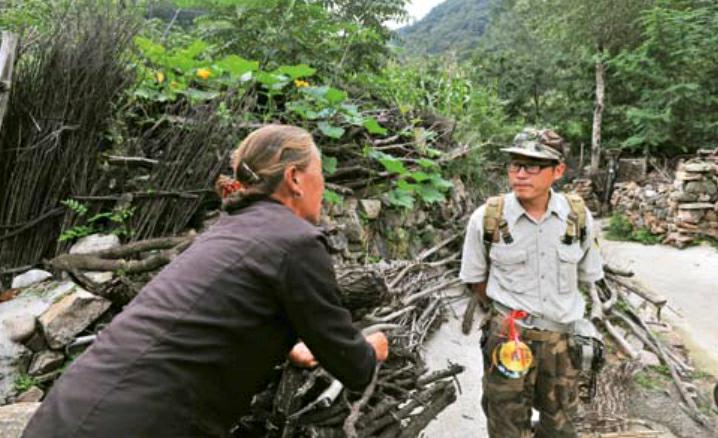Protecting Wildlife
by+Gao+Yuan
In 2000, 18-year-old Li Li established an advocacy center for animals – Black Leopard Wildlife Conservation Station – in Fangshan District, Beijing. It has been 15 years since its founding, and the work has been going on without any government support. The routine includes mountain patrol, poaching prevention, installation of infrared detectors, and managing “conflicts”between villagers and wild animals.
As a matter of fact, Li Li is a painter.“Painting is just my hobby,” he grins, “and I pay my bills with the paintings I sell. My true love is protecting wild animals.”
For Those Good Old Days
Li Li grew up somewhere around Youanmen in Beijing. More than 20 years ago, that area was mainly villages and vegetable fields. In those days, while his parents were busy working, Li played a lot every day in the fields. He wouldnt return home for dinner until his grandmother called.“Unlike other kids, who were obsessed with transformers, I spent most of my time observing how parent birds fed their babies, how frogs hatched, and how swans played,”he recalls. “My only ‘buddy was a little wild rabbit. That was a lot of fun!”
Those days are gone. His house – demolished – was one of the casualties of urbanization and construction projects in Beijing. “My parents took my sister to the new home; but my grandma and I were reluctant to leave before the house was pulled down,” Li continued. “My land of promise had gone away. But, I must do something to protect those little animals for the sake of my childhood memories.”
The year 2000 saw the establishment of his protection station when Li was still in junior high school. He and his young friends together spread awareness about wildlife protection and patrolled the mountains to prevent illegal hunting. Five years later, many of his partners quit because dearth of funds made it tough. The station was about to be closed.
To keep things going, Li Li left two volunteers behind in the station and set out to have a shot at making money with his talent for painting and business. He returned with his first bucket of gold from selling paintings and running an art gallery. “I was so happy that I could afford all facilities required: car, camera, rock climbing gear, GPS, and infrared detectors…Nevertheless, I had trouble using them. Fortunately, I got to know a professional, Xie Yan, who helped us a lot.”

Learning to Be Professional
Xie Yan, a specialist from the Institute of Zoology under the Chinese Academy of Sciences, used to work as director of Wildlife Conservation Society (WCS) China Program. Thanks to her assistance, Li Li and his team learned how to protect wildlife in a professional way. They took turns at working in the station while sending others out to places such as Sichuan and Yunnan provinces to practice field tracking, learn how to use monitoring devices and analyze data, and study birds and reptiles. Soon, they got involved in wildlife protection projects across the country.
In recent years, Li Li has taken part in a research project on Siberian tigers in northeastern China and the investigation of Tibetan antelopes and buffalos in Hoh Xil, Tibet Autonomous Region. He thus gained abundant experience from his daily practice of capturing animals, sampling, and releasing them.
These efforts have enabled Li and his team to use what they have learned in awareness campaigns amongst local villagers; and, in solving problems between man and animals.
In the past two years, they have tackled two major problems: vultures devouring sheep in winter and wild boars ransacking cornfields in autumn.
After thorough investigation, Li and his team members suggested that villagers give up attempts at killing vultures with splints and leave the matter to them. Further, they asked shepherds to avoid herding on the mountain top in winter and built a terrace there for feeding vultures with pork. Since then, people have not been bothered by vultures.
Autumn is the harvest season for corns. To ward off wild boars, they hang used discs around the fields, which can reflect light to scare off boars, scattered wolf and leopard excrement, plant mint, and play audios of howling animals atop the mountain.
Li takes pride in what he has achieved in protecting black storks, an endangered species with only about 2,000 left in the world. In 2000, three were found in Fangshan District; and his team began tracing and monitoring the local black storks and called for protection through various means.
Today, the population of black storks has grown to 60 thanks to their 14 years of unremitting efforts. In 2014, the municipal government of Beijing established 20 stations for the protection of black storks; and China Wildlife Conservation Association recognized Fangshan District as the “Home of Black Storks in China.”
True, Lis station is eligible to apply and get 1 million yuan for the project to protect black storks. But he left that to the local government of Fangshan, and offered it all his data from tracking and monitoring, besides photos, videos, and GPS locations.
Many of his partners doubted about his offer, but Li insisted, “For the purpose of black stork protection, its a long-term guarantee to the government. The first lesson I learned from Xie was her conception of an NGO as one which acts before the government and forwards its achievements to the government.”
China Pictorial2015年12期
